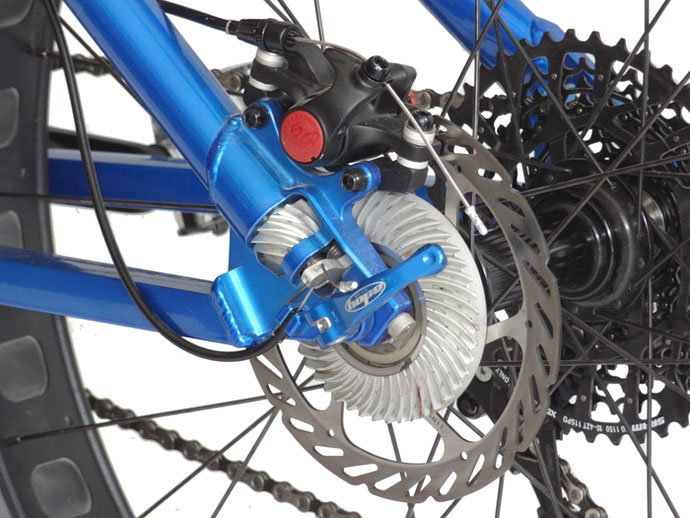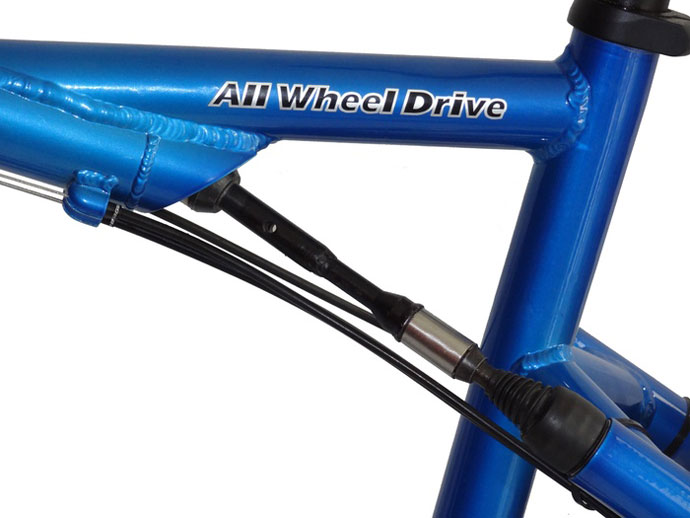
For most of us, preparation for winter riding means a set of mudguards, but for Kate Leeming, it involves commissioning all-wheel drive bicycles capable of tackling the wilds of Antarctica.
Kate aims to make the first bicycle crossing of the Antarctic continent via the South Pole – a task that requires as much technical assistance as she can muster.
Christini Technologies made its name building off-road motorcycles before turning its attention to all-wheel drive bicycles.

The Christini AWD Fat Bike runs 5” rims on 29” wheels and weighs in at 14.5 kg.

Christini Technologies builds the world’s only all-wheel drive mountain bikes, which deliver power from the rear of the bicycle to the front wheel via a series of gears, shafts, and chain mounted within or on the frame.
A recreation of the AWD Antarctica bike – albeit running on running on slightly narrower 4” rims – is available to buy via Kickstarter for £4,000.
Long before the advent of the mountain bike, let alone all-wheel drive bicycles, pioneer adventure cyclists of the 1890s took to the snowy wilds of northern Canada. In the search for gold, those who didn’t have the money to invest in dog teams used bicycles.

Hardy soul: The cover of Terrence Cole’s account of Alaskan cycling at the turn of the twentieth century, Wheels on Ice.
By following in the dogsled tracks the intrepid ‘wheelmen’ cyclists were able to make good time. The bicycles might have been cheaper to buy and maintain than a team of dogs, but they suffered from frozen bearings and tyres. 19-year-old Max Hirschberg chose to use a bicycle when he joined the gold rush in 1900. His journal gives a fascinating insight into the cold weather gear of the day:
“The day I left Dawson, March 2, 1900, was clear and crisp, 30° below zero. I was dressed in a flannel shirt, heavy fleece-lined overalls, a heavy mackinaw coat, a drill parka, two pairs of heavy woollen socks and felt high-top shoes, a fur cap that I pulled down over my ears, a fur nosepiece, plus fur gauntlet gloves. On the handlebars of the bicycle I strapped a large fur robe. Fastened to the springs, back of the seat, was a canvas sack containing a heavy shirt, socks, underwear, a diary in waterproof covering, pencils and several blocks of sulfur matches. In my pockets I carried a penknife and a watch. My poke held gold dust worth $1,500 and my purse contained silver and gold coins. Next to my skin around my waist I carried a belt with $20 gold pieces that had been stitched into it by my aunt in Youngstown, Ohio, before I left to go to the Klondike.”
Over the coming weeks Hirschberg faced numerous perils. Just short of his journey’s end, the intrepid cyclist skidded on ice and broke his bike’s chain. Undaunted, Hirschberg took advantage of the bitterly cold tail wind to rig his bike with sail. He lashed a branch to his bike frame in place of a mast and his parka served in place of sail cloth. At times the wind was so strong that he was forced to drive into soft snow to stop his wild flight.
Bicycle insurance that’s different
Cycle insurance from the ETA offers a comprehensive level of cover at a competitive price and includes up to 90 days worldwide cover as standard.
We never devalue your bike or charge extra for things like third party liability, personal accident or friends and family cover. On top of that, we have a sympathetic policy on storage in sheds and garages.
For over 26 years we have been providing straightforward, affordable bicycle insurance and earlier this year we were voted Britain’s most ethical insurer.
Find out more about why we are different. Get an instant quote or call our friendly team on 0333 000 1234.
0 Comments View now